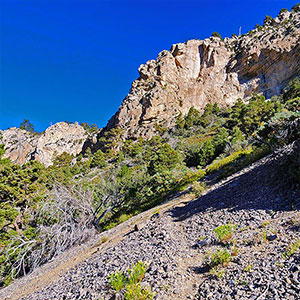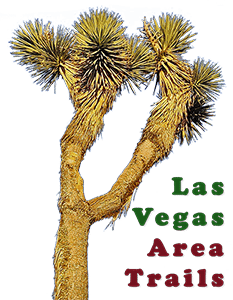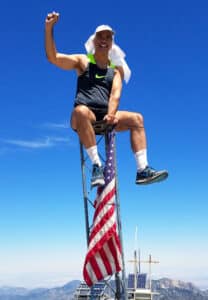Begin at the Fletcher Canyon Trailhead, then pass through Fletcher Canyon to the base of Fletcher Peak. Leave Fletcher Canyon an ascend to Fletcher Peak summit. From Fletcher Peak summit take the Fletcher Peak and North Loop Trails to the Trail Canyon Trail junction at Cockscomb Ridge. Ascend the Cockscomb Ridge Trail to a mid-point on the ridge, then descend the Eastern wilderness below Cockscomb Ridge to connect with the Stanley B. Springs Trail. Take the Stanley B. Springs Trail to its trailhead on Kyle Canyon Road, then return to your start point at the Fletcher Canyon Trailhead.
I thought that reaching Fletcher Peak summit from Fletcher Canyon would be pretty easy. It’s only a few linear miles. However, those intervening cliffs and slopes! The unexpected discovery of a hidden, actual trail changed everything!
Wilderness connections transform a random collection of trails into one unified wilderness. You may have experienced Fletcher Canyon Trail as a nice trail winding up a beautiful forested area that eventually becomes a spectacular slot canyon, then finally is blocked at the upper end by a steep ledge. There’s nothing wrong with this interpretation of the area. You’re in the wilderness, and all adventures there create a connection with nature.
However, to experience the larger surroundings may incredibly add to the wonder of the ground upon which you tread. Imagine that canyon, Fletcher Canyon, as the very base of a 10,319ft mountain, Fletcher Peak. And, that mountain directly above the canyon is blanketed with an ancient bristlecone pine forest up to 3,000 years old, predating the times of classical Greece! Up there on Fletcher Peak one can connect with the familiar Fletcher Peak Trail, North Loop Trail and and Trail Canyon Trail. These are now transformed from isolated trails as they are drawn into the “One Wilderness” connection.
As you begin to ascend above the Fletcher Canyon floor, the six highest peaks in the Spring Mountains come into view along the high circular 10-11,000ft rim of Kyle Canyon. There’s Harris Mountain, Griffith Peak, Charleston Peak, Lee Peak, Mummy Mountain and Fletcher Peak. And, in the distance there’s the Sheep Range, Gass Peak, the Las Vegas Valley and too many points beyond to list here. Now, that beautiful, winding Fletcher Canyon has become part of an expansive, endless wilderness. This is the power of making the connections that transform that random collection of trails into one unified wilderness!
This adventure allows you to experience these connections by crossing the artificial boundaries people have created as we emerge from one wilderness area into neighboring wilderness areas.
All the time, know that you are treading on sacred ground, so tread lightly and leave no trace!
The Summer months are free of snow, present greater visibility, longer days and cooler temperatures compared to the Las Vegas Valley below. For every 1000ft elevation gain, the air cools by about 5 degrees. This means that a 115-degree day at about 1,000ft in the Las Vegas Valley translates to around 70 degrees at 10,319ft on Fletcher Peak summit and as low as 60 degrees on 11,919ft Charleston Peak summit. If you have cabin fever trapped in small air conditioned enclosures down in Las Vegas, ascend the Spring Mountains for expansive views, gentle breezes and comfortable temperatures!
Driving to the Fletcher Canyon Trailhead is pretty easy: Up I-95 North from Las Vegas, take a left at the Kyle Canyon exit, continue about 20 miles up Kyle Canyon Road, pass the traffic circle at The Spring Mountains Visitor Gateway, pass the Deer Creek Road turnoff and Mt Charleston Lodge and then onward for less than a quarter mile to The Fletcher Canyon Trailhead parking on your left. In all, it’s less than 40 miles from the Las Vegas Strip.
The big challenge of getting from Fletcher Canyon to Fletcher Peak is the imposing line of cliffs above Fletcher Canyon blocking progress to Fletcher Peak for all but experienced rock climbers. I’m going to show you how to get from Fletcher Canyon all the way to Fletcher Peak without doing any rock climbing beyond a few very light class 2+ scrambles. The key involves discovery of a hidden trail that navigates through the imposing cliff line above Fletcher Canyon.
Continue beyond the Fletcher Canyon Trailhead up Fletcher Canyon Trail, past the intersection with the Eagle’s Nest Loop Trail and up Fletcher Canyon until the wide gravel trail comes to an end. At that point, you have two choices:
If your goal is Fletcher Peak, you’ll choose option #2 above. The nice trail will begin to switchback above Fletcher Canyon, eventually reaching the base of the cliff line. The trail gets you to a gully you can continue to ascend through the cliffs and onward toward Fletcher Peak. In the video on this page I made the mistake of trying to ascend the slopes above the gully. Bad bad! When the trail ends at the gully, just take the gully upward. The slopes above the gully were very steep with a loose rock surface. And, it turns out that after that brutal little stretch on the slopes I ended up at a higher point in the gully! Little punishing deviation I could have avoided if I’d just taken the gully beginning at the top of the trail. Hindsight makes it clear that the trail is meant to get you to the gully that will take you through the cliff line.
Assuming you’ve decided to take the gully (Good choice!), simply continue up the gully avoiding the temptation to ascend the right or left side. Eventually the gully will become shallow and all but disappear. By this time, you’re in a beautiful, wide open Bristlecone Pine forest and the angle of ascent has measurably decreased. It’s a nice walk through the forest, about 5-700 feet below the summit of Fletcher Peak!
The route is pretty easy. Just angle slightly to the right and keep heading upward to the highest point you can see. That highest point is the forested area just East of the official summit of Fletcher Peak. Actually, Fletcher Peak has a double summit. There’s the official summit with the summit box and the view, and just 50 yards (half a football field) to the East, there is a forested summit exactly the same elevation. Between the two summits there is a shallow saddle. So, when you arrive on the forested summit to the East of Fletcher Peak, descend the saddle to the West and then ascend to the official summit of Fletcher Peak.
From Fletcher Peak’s official summit, descend the Fletcher Peak Trail to its connection with the Mt. Charleston North Loop Trail. Take a left onto the North Loop Trail. There are no trail markings, but you’ll know when you hit the North Loop Trail. Now, take the North Loop Trail to the famous 3,000-year-old ancient bristlecone pine called “Raintree”.
At Raintree, turn left to continue down the North Loop Trail. Had you turned right at Raintree, you’d be heading toward Mummy Springs. Save that for another adventure.
Continue down the North Loop Trail until its junction with the Trail Canyon Trail. You have three choices here. Take the third:
For me, this was the most complicated stretch of the day, and I was racing against late afternoon and sunset! Wasn’t confident I’d make it out of the pathless wilderness before nightfall until I actually landed on the Stanley B. Springs Trail.
The key is to begin heading up the Cockscomb Ridge Trail until just before the rocky peak area. At that point, angle left heading downward along the Eastern base of Cockscomb Ridge. There are no trails. It’s pure wilderness. Try to navigate as high along the base of the Cockscomb Ridge cliff line as possible. You’ll navigate over four perpendicular descent ridges (I think that’s the right number…sorry!) Head down the fourth descent ridge and angle downward into the gully on the far side below that ridge. That gully will take you to Stanley B. Springs, the abandoned mine there.
Note that if you head downward before that fourth descent ridge and its far gully, you are likely to arrive at the edge of a cliff drop-off above Fletcher Canyon and have to do some back-climbing as I did on this day.
This final stretch is the easiest stretch of the day! At Stanley B. Spring and its abandoned mine there begins a beautiful trail that will take you all the way down to Kyle Canyon Road. On this day, the spring was flowing with enough force that it covered the trail at first, but only about an inch deep. Eventually, the trail split from the spring, continuing downward. If you take a left fork just above Kyle Canyon Road you will cut off a little distance, but whether you take that left fork or not, you’ll arrive on Kyle Canyon Road where you will turn left and in about a mile arrive at your starting point, the Fletcher Canyon Trailhead!
Congratulate yourself! You’ve navigated one of the most challenging circuit routes in the Spring Mountains and, in the process, seen spectacular views and deep wilderness that very few people will ever experience! Just try to time things so you don’t end up in the wilderness after dark. Two many dangerous drop-offs to navigate in the dark on that final stretch. And if you’re like me, you probably didn’t prepare to spend the night in the wilderness.



Return often to experience one new adventure each week! From the home page scroll to “Most Recent Adventures“. More about David Smith…
The trail adventures on this website require proper conditioning, preparation and safety precautions. There are many factors beyond our control including weather conditions, unstable ground, loose rocks, insects and snakes, people you may encounter, your own level of physical conditioning, the potential of getting lost just to mention a few. While this site offers guidance, helpful tips, direction and training, the reader assumes full responsibility for whatever may occur during their trail adventure. Have fun and be safe!